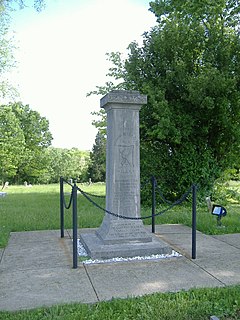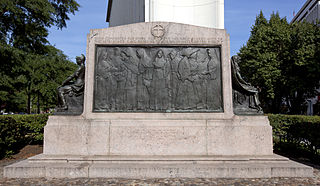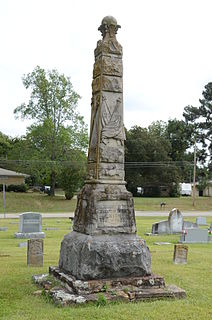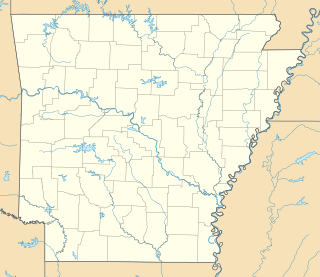
The Washington Monument is an obelisk within the National Mall in Washington, D.C., built to commemorate George Washington, once commander-in-chief of the Continental Army (1775–1784) in the American Revolutionary War and the first President of the United States (1789–1797). Located almost due east of the Reflecting Pool and the Lincoln Memorial, the monument, made of marble, granite, and bluestone gneiss, is both the world's tallest predominantly stone structure and the world's tallest obelisk, standing 554 feet 7+11⁄32 inches (169.046 m) tall according to the U.S. National Geodetic Survey or 555 feet 5+1⁄8 inches (169.294 m) tall according to the National Park Service. It is the tallest monumental column in the world if all are measured above their pedestrian entrances. Overtaking the Cologne Cathedral, it was the tallest structure in the world between 1884 and 1889, after which it was overtaken by the Eiffel Tower in Paris.

The Korean War Veterans Memorial is located in Washington, D.C.'s West Potomac Park, southeast of the Lincoln Memorial and just south of the Reflecting Pool on the National Mall. It memorializes those who served in the Korean War.

The Lincoln Tomb is the final resting place of the 16th President of the United States, Abraham Lincoln; his wife, Mary Todd Lincoln; and three of their four sons, Edward, William, and Thomas. It is located in Oak Ridge Cemetery in Springfield, Illinois. Constructed of granite, the tomb has a single-story rectangular base, surmounted by an obelisk, with a semicircular receiving room entrance-way, on one end, and semicircular crypt or burial-room opposite.

There have been several remembrances of the Mountain Meadows Massacre including commemorative observances, the building of monuments and markers, and the creation of associations and other groups to help promote the massacre's history and ensure protection of the massacre site and grave sites.

The Colored Soldiers Monument in Frankfort, Kentucky's Green Hill Cemetery, at the junction of US 60 and US 421, is the only Kentucky monument honoring black soldiers that participated in the American Civil War, and one of only four in the entire United States. Erected by the Women's Relief Corps No. 8, an auxiliary of the Grand Army of the Republic, it was unveiled on July 4, 1924. The only other monument built by GAR in Kentucky is the GAR Monument in Covington.

The Trenton Battle Monument is a massive column-type structure in the Battle Monument section of Trenton, Mercer County, New Jersey, United States. It commemorates the December 26, 1776, Battle of Trenton, a pivotal victory for the Continental forces during the American Revolutionary War.
Alfred-Alphonse Bottiau was a French sculptor. He was born in Valenciennes and after early studies in his home town he studied in Paris under Jean Antoine Injalbert and was runner-up for the Prix de Rome for sculpture in 1919. Bottiau had joined the army in 1910 and served until 1919. He was director of the Écoles Académiques de Valenciennes from 1946 to 1951.

Nuns of the Battlefield is a public artwork made in 1924 by Irish artist Jerome Connor, located at the intersection of Rhode Island Avenue NW, M Street, and Connecticut Avenue NW, in Washington, D.C., United States. A tribute to the more than 600 nuns who nursed soldiers of both armies during the American Civil War, it is one of two monuments in the District that mark women's roles in the conflict. It is a contributing monument to the Civil War Monuments in Washington, D.C., listed on the National Register of Historic Places. In 1993, it was surveyed for the Smithsonian Institution's Save Outdoor Sculpture! program.

The General William Tecumseh Sherman Monument is an equestrian statue of American Civil War Major General William Tecumseh Sherman located in Sherman Plaza, which is part of President's Park in Washington, D.C., in the United States. The selection of an artist in 1896 to design the monument was highly controversial. During the monument's design phase, artist Carl Rohl-Smith died, and his memorial was finished by a number of other sculptors. The Sherman statue was unveiled in 1903. It is a contributing property to the Civil War Monuments in Washington, D.C. and to the President's Park South, both of which are historic sites listed on the National Register of Historic Places.

The Soldier's Monument is a historic structure in the College Square Historic District in Davenport, Iowa, United States. The district was added to the National Register of Historic Places in 1983. The monument, which was built from 1880 to 1881, was individually listed on the Davenport Register of Historic Properties in 1993.

The Stephenson Grand Army of the Republic Memorial, also known as Dr. Benjamin F. Stephenson, is a public artwork in Washington, D.C. honoring Dr. Benjamin F. Stephenson, founder of the Grand Army of the Republic, a fraternal organization for Union veterans. The memorial is sited at Indiana Plaza, located at the intersection of 7th Street, Indiana Avenue, and Pennsylvania Avenue NW in the Penn Quarter neighborhood. The bronze figures were sculpted by J. Massey Rhind, a prominent 20th-century artist. Attendees at the 1909 dedication ceremony included President William Howard Taft, Senator William Warner, and hundreds of Union veterans.

The Black Hawk County Soldiers Memorial Hall, also known as Veterans Memorial Hall, is a Classical Revival veterans hall located at 194 West Fifth Street in downtown Waterloo, Black Hawk County, Iowa. It was built from 1915 to 1916 by the Grand Army of the Republic as a memorial to soldiers who died in the American Civil War. It was listed on the National Register of Historic Places in 1988 due to its architecture and importance in local history.

The Grand Army of the Republic Monument of Judsonia, Arkansas is located in the city's Evergreen Cemetery, on Judson Avenue north of its downtown. The monument consists of a rusticated fieldstone base, on which a cubical stone with inscriptions has been set. This is topped by an obelisk-like tapering marble element with a square cross section, which is topped by a sphere adorned with floral detailing. It is set in a square area 31 feet (9.4 m) on each side, in which a number of Union Army soldiers are buried. The monument was placed in 1894 by the local chapter of the Grand Army of the Republic, a Union Army veterans' organization. White County, where Judsonia is located, was divided in the war, with men from the county serving on both sides in the conflict.

The David O. Dodd Memorial is a monument on the grounds of the Old State House in Little Rock, Arkansas. Erected in 1923 by Confederate memorial groups, it commemorates David O. Dodd, an Arkansas civilian who was executed by the U.S. Army for spying. The monument has a horizontal base of gray marble, with a central columnar component, in which a relief portrait of Dodd is carved into white marble. It was listed on the National Register of Historic Places in 1996.

The Memorial to Company A, Capitol Guards was an American Civil War memorial in MacArthur Park, Little Rock, Arkansas. It stood just northeast of the former Tower Building of the Little Rock Arsenal, at a junction of two of the park's internal roadways. It consisted of a bronze sculpture depicting a Confederate Army soldier in a defensive stance, holding a rifle pointed forward. The statue was 8 feet (2.4 m) in height, and was mounted in a granite column 16 feet (4.9 m) tall. The memorial was sometimes known as "Lest we forget", a line that appeared near the top of the inscription on the base. The statue was created by sculptor Rudolph Schwarz, and was installed in 1911; it was paid for by the local chapter of the Sons of Confederate Veterans, and memorializes the unit that seized the arsenal at the outset of the war.

World War I Cenotaph is a heritage-listed memorial at Jubilee Park, Alfred Street, Mackay, Mackay Region, Queensland, Australia. It was designed by Stephen Harvey and built from 1928 to 1929 by Melrose & Fenwick. It is also known as Mackay War Memorial and Jubilee Park. It was added to the Queensland Heritage Register on 21 August 1992.

Sac City Monument Square Historic District is a nationally recognized historic district located in Sac City, Iowa, United States. It was listed on the National Register of Historic Places in 2015. The square consists of the General Sherman Hall (1892), Memorial Statue (1894), the American Legion Hall (1922), four World War II era Howitzers, and three granite tablets that commemorate the lives of the soldiers from Sac County who fought in World War I, World War II, the Korean War, and the Vietnam War. The Vietnam War tablet does not contribute to the historic district because it is a more recent installation.

The Gentry Grand Army of the Republic Memorial is an American Civil War monument in the northeast section of Gentry Cemetery in Gentry, Arkansas. It is a limestone structure with Classical Revival features, consisting of a stepped square base, a tier of marble panels framed by round columns, and a tapered obelisk topped by a carved capital and round knob. Two of the marble panels are inscribed with the names of soldiers who served in the Union Army. The monument was installed in 1918 through the efforts of David Kost, a Civil War veteran who organized Gentry's chapter of the Grand Army of the Republic (GAR). It is one of a relatively small number of GAR memorials in the state.



















